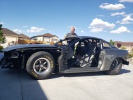From the document I provided. The movement of the intake camshafts will advance (before TDC) the intake valve timing from TDC . The movement of the exhaust camshafts will retard (after TDC) the exhaust valve timing from TDC . The chart basically explains when and why camshafts are moved. At idle you would have least overlap for maximum compression ratio, idle quality, quick warm up of engine and cats, cold start emissions. Intake overlap scavenges cylinder of exhaust gases. Off idle, the exhaust overlap takes the place of an egr valve by pulling "inert" exhaust back in the cylinder, reducing the displacement of the cylinder (volumetric efficiency/airmass), reducing fuel, and reducing cylinder temps. for emission purposes and fuel economy. Less heat, less N0x emissions. High rpm and load will reduce overlap, increase displacement (volumetric efficiency/airmass) , add more fuel and increase performance.




 Reply With Quote
Reply With Quote
